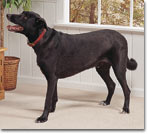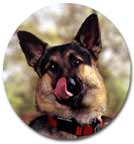Body Language: A Clue He May Be Anxious
Veterinary & Aquatic Services Department, Drs. Foster & Smith, Inc.
 If you are around dogs long enough, especially dogs that interact with each other, you will notice that they use specific signals to communicate certain things to each other. Animal behaviorists believe some of these signals are meant to relax potential aggressors, as well as calm themselves. If you are around dogs long enough, especially dogs that interact with each other, you will notice that they use specific signals to communicate certain things to each other. Animal behaviorists believe some of these signals are meant to relax potential aggressors, as well as calm themselves.
Canine language takes form in facial expressions, ears, tail, body movement, and sound. And certain body signals are thought to curtail aggression. If you have multiple dogs, observe them when they are wrestling. When things begin to escalate out of control, they signal each other to stop. This type of behavior is thought to foster cooperation among pack members.
If you are observant enough of your particular dog's use of calming signals, experts say you can even use them yourself to calm your dog during times of stress. Check out your dog during particularly anxious moments: at the veterinarian's office or in obedience class when he does something wrong, for example. You will probably see him yawn, sniff the ground or inanimate objects, or even lick his nose.
If your dog has the opportunity to encounter unfamiliar dogs or people at a public dog park or even on the street, you may see him display some body language that is meant to say, "look, I am not a threat to you." Some typical signs you may see include:
- Sniffing the ground: This is thought to be a signal from a fearful dog to calm another creature (human or animal) that may frighten him.
- Turning the head, head held to the side, or eyes flicking to the side for just an instant.
- Your dog may even do this when a child runs up to give him a hug!
- Sometimes, this takes place in such a short time you may not catch it.
- You can use this signal to greet a new dog that may be fearful by coming up to the dog at an angle, or by looking away.
- Remember to let children know never to approach a strange dog by staring at him. This indicates aggression in dog language. Better yet, never let a child approach any unknown dog without immediate adult supervision.
 Licking his own nose: Quick or slow, this also is thought to be a signal to calm strangers. Interestingly, black dogs use this signal more often than other dogs. This may be because their features are more difficult to see and a pink tongue stands out. Licking his own nose: Quick or slow, this also is thought to be a signal to calm strangers. Interestingly, black dogs use this signal more often than other dogs. This may be because their features are more difficult to see and a pink tongue stands out.
- Licking your face or another dog's face, although a typical canine greeting, may or may not also be a calming signal.
- Yawning: This is a common stress signal. We have noticed this in dogs during obedience training when their owners are expecting a lot of them, at dog shows, at the veterinarian, or when their owners are disciplining them.
If you own an older dog, try some of these signals to calm him down. Older dogs are much more sensitive to their owner's body language (that is why they sometimes seem to be able to read our minds).
Try communicating with your dog in his own language. He may look at you strangely, but it may just work.
© 2000 Drs. Foster and Smith, Inc.
Reprinted as a courtesy and with permission from
PetEducation.com ("http://www.peteducation.com/")
On-line store at "http://www.drsfostersmith.com/"
Free pet supply catalog: 1-800-323-4208 |